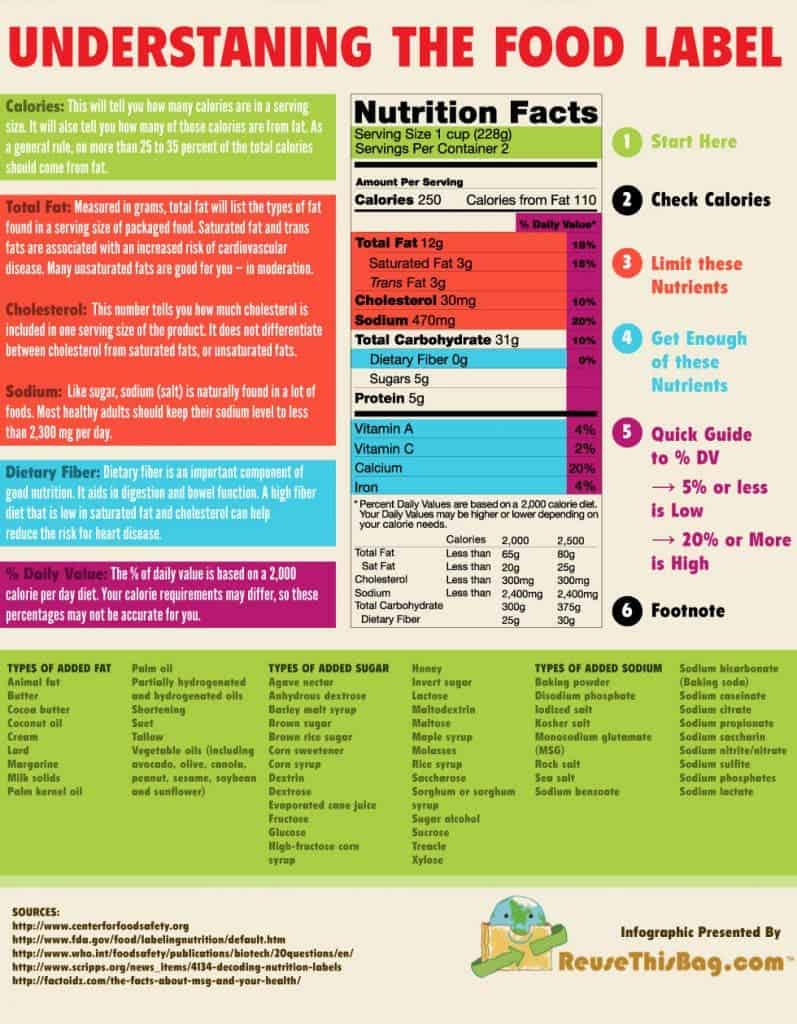Nutritional labels can be daunting to read if you have no idea what to look for. Most of us don’t have the time and energy to work out what these mean, so we buy on impulse.
Naturally, you’d think something as important as a product’s nutritional facts was presented in a more straightforward manner. But apparently, nutritional labels lead to decisions that are indistinguishable from chance. In other words, only a few actually make informed choices after reading the label. Alas, it’s futile to debate which labeling system is the right one — instead, let’s see how we can get the best out what we have now. Let’s look a couple of label reading tips.

1 – The overview
This will tell you the size of a single serving and the total number of servings per container or package. This will vary from product to product.
2 – Check total calories per serving
Be careful here. The listed calories are per serving, so if you eat the whole package you’re in fact consuming “calories per serving” x “number of servings”. If you eat two servings, you’re doubling your calorie and nutrient intake listed on the label.
Most Americans eat more calories than they should on a daily basis but intake fewer nutrients than they should.
[panel style=”panel-info” title=”As a rule of thumb” footer=””]40 Calories is low
100 Calories is moderate
400 Calories or more is high[/panel]
3 – Limit some of these nutrients
The key nutrients that impact your health are divided into two main groups: the ones you should limit (fat, cholesterol, sodium) and those you should get more ( fiber, vitamin A, vitamin C, calcium, and iron).
[panel style=”panel-warning” title=”Limit this” footer=””]Based on a 2,000 calorie diet, you should consume no more than 11-13 grams of saturated fat, as little trans fat as possible, and no more than 1,500 mg of sodium. [/panel]
Sugar itself isn’t bad — not if you consume it responsibly. No daily reference value has been established for sugars because no recommendations have been made for the total amount to eat in a day. If you need to lose weight, keep sugar intake low. Also check for sugar alternatives like dextrose, fructose, glucose, golden syrup, honey, maple syrup, sucrose, malt, maltose, lactose, brown sugar, caster sugar, maple syrup, raw sugar, sucrose
4 – Get enough of these nutrients
Make sure you get enough of beneficial nutrients such as dietary fiber, protein, calcium, iron, vitamins and other nutrients you need every day.
These nutrients can improve your heath and reduce the risk of diseases. For instance, getting enough calcium can help prevent osteoporosis which causes brittle bones at old age. A diet in high fiber promotes healthy bowel function. This is why everyone recommends eating fruits, veggies and grain as these contain soluble fiber and are low in saturated fat.
This is why everyone recommends eating fruits, veggies and grain as these contain soluble fiber and are low in saturated fat.
5 – % Daily Value.
The % Daily Values (%DVs) is based on the Daily Value recommandations for key nutrients. However, you must keep in mind that these percentages are based on a 2,000 daily calorie diet. You might need more or fewer calories, but the DV is still a useful baseline.
The %DV tells you fast if a serving is high or low in a nutrient. Notice: some key nutrients, like trans fat, do not have %DV listed.
Also, if you add up all the %DVs you won’t get 100%. That’s because each nutrient is counted relative to the 100% daily requirement for that nutrient, again for a 2,000 calorie diet.
[panel style=”panel-info” title=”%DV at a glance” footer=””]As a guide, if you want to consume less of a nutrient (such as saturated fat or sodium), choose foods with a lower % DV — 5 percent or less. If you want to consume more of a nutrient (such as fiber), seek foods with a higher % DV — 20 percent or more.[/panel]






